|

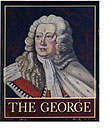 At lunchtime on Saturday 16 January 2010, workmen boarded-up all the ground floor windows and doors of this grade II building, ending and encapsulating the life and times of Stortford's oldest recorded pub. Between 2001 and the present day (2010), social economics and new laws have helped force the closure of seven pubs throughout the town but none suspected the daddy of them all would also become a victim of the same factors. At lunchtime on Saturday 16 January 2010, workmen boarded-up all the ground floor windows and doors of this grade II building, ending and encapsulating the life and times of Stortford's oldest recorded pub. Between 2001 and the present day (2010), social economics and new laws have helped force the closure of seven pubs throughout the town but none suspected the daddy of them all would also become a victim of the same factors.
Put up for auction sale by owners Punch Taverns in January 2010, The George was bought for £1m by Italian restaurant chain, Prezzo. The firm is expected to invest a further £1m to renovate the now somewhat dilapidated 26-room property and open anew in the summer of 2010.
This new chapter in the building's history will never compare to that of the past 600 years, so let's remember how it was.
The original foundations were laid down at the end of the 14th century and first mention of the inn was in 1417 when one Thomas Petworth kept it. Ownership later transferred to the Hawkins family of the Manor of Piggotts at Thorley, who regularly held their manorial courts here in the 15th century. It remained in their ownership for 300 years.
The inn’s central position in the town suggests it was purpose built and it’s quite possible many of the skilled masons involved in the rebuilding of St Michael’s church during the early 15th century were housed here. We know for certain that in 1482, churchwarden William Shepperd paid one Richard Barlee 8s. 4d. (42p) at the ‘Jerge’ (George) for a ‘bote’. This was the boat in which two churchwardens rowed to Fulham in London, via the rivers Stort, Lea and Thames, and there discussed with the bishop acquisition of Chantry lands for Bishop’s Stortford (See Guide 5).
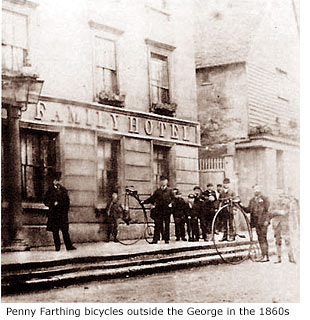 Two memorable years in the town’s history were 1629 and 1630, when Charles I ‘dyned at ye George’ and the bells of St Michael’s church rang out to celebrate the fact. That same century, Charles II rejected the royal palaces at Theobalds and Royston in favour of a move to Newmarket, making Bishop’s Stortford, and in particular the George, a convenient mid-way stop for him and his entourage while journeyings to and from London. Coupled with his love of the Newmarket races the King’s visits were frequent, but he disliked travelling through the busy town centre and hated even more the sight of the ‘cage’ that stood in the road outside the George. Two memorable years in the town’s history were 1629 and 1630, when Charles I ‘dyned at ye George’ and the bells of St Michael’s church rang out to celebrate the fact. That same century, Charles II rejected the royal palaces at Theobalds and Royston in favour of a move to Newmarket, making Bishop’s Stortford, and in particular the George, a convenient mid-way stop for him and his entourage while journeyings to and from London. Coupled with his love of the Newmarket races the King’s visits were frequent, but he disliked travelling through the busy town centre and hated even more the sight of the ‘cage’ that stood in the road outside the George.
Most small communities had a lock-up, or cage. It was where felons were held for short periods before being brought before a justice or transferred to other secure accommodation, but generally they held drunks who were released as soon as they sobered up. The term 'cage' is misleading, most early lock-ups being built of wood, rather like a shed, and later versions built of stone and sometimes quite ornate. A bench seat would have been a luxury and sanitation was no more than a bucket.
In 1718, Stortford's cage was moved further along North Street to stand outside the White Horse Inn (now Pizza Express), remaining there until the early 19th century when it was moved to Causway. The natural successor to the cage was the police cell.
By 1675 the Hawkins family seem to have relinquished the George, records showing they then held only a malthouse attached to it. This was probably the same barn referred to that year when new owner, William Layer of Cambridgeshire, leased the George to Thomas Doncaster and Philip Mills, ‘together with adjacent barn’ in the High Street.
Shortly after 1800 the barn was demolished and replaced by five cottages. These were later incorporated into the main building, heightened to three storeys and roofed with four gables front and back. This is the part of the George that now stretches into the High Street.
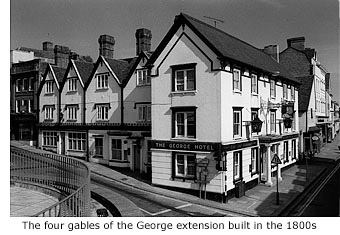 From the late 18th century to the early 19th century the inn served as Bishop’s Stortford’s Excise Office and, later, as a terminus for stagecoach services journeying to and from London and Saffron Walden. Two Stortford based coaches were owned by Henry Gilbey and William Low (See Guide 4). Gilbey's coach left the George at 5 am on a Monday morning and arrived in London at the Bull Inn, Aldgate, around 9 am. The return journey departed around 4 pm. On other days of the week the coach left for London at 8 am, running daily during the summer months and on alternate days in winter. From the late 18th century to the early 19th century the inn served as Bishop’s Stortford’s Excise Office and, later, as a terminus for stagecoach services journeying to and from London and Saffron Walden. Two Stortford based coaches were owned by Henry Gilbey and William Low (See Guide 4). Gilbey's coach left the George at 5 am on a Monday morning and arrived in London at the Bull Inn, Aldgate, around 9 am. The return journey departed around 4 pm. On other days of the week the coach left for London at 8 am, running daily during the summer months and on alternate days in winter.
In 1816 the inn was bought by local brewery Hawkes, and from 1835 was used as a meeting place by the Guardians of the Union Workhouse. Like the Chequers Hotel and the Crown Inn at Hockerill, it was also a meeting place for Bishop’s Stortford’s masonic lodge. Another of its regular uses throughout the 19th and early 20th century was for auction sales organised by Sworders – many of the towns properties being sold here.
Use of a different kind came in the 1950s when the town’s rugby club was re-formed. Void of any facilities at their Silver Leys ground, the landlord, a staunch supporter of the club, renovated a small barn at the rear of the inn for use as a changing room, at the same time installing a large bath. In common with most old buildings in this area The George is said to be haunted by the ghost of the Grey Lady (see below).
Modernisation of the inn took place in the 17th and 18th century, and again in the early Victorian period when the exterior was given its present appearance, including the channelled rustication on the ground floor. In November 1964, yet another moment of town planning madness occurred when there was a proposal to demolish the inn. Thankfully, it was stopped in its tracks by Ministerial intervention.
Up until the early 1900s the inn carried a traditional sign depicting St George and the Dragon, then until its closure showed a portrait of the Hanoverian King George III. This was probably acceptable as he was the first Hanoverian monarch to actually be born in England. MORE PICTURES
|
|
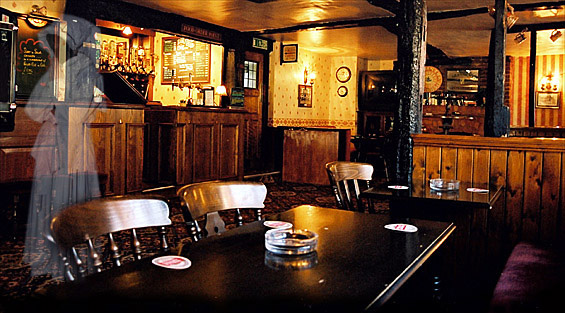 |
|
Ghosts of Bishop's Stortford
|
|
|
|
|
|
It’s actually quite surprising that a medieval town like Bishop’s Stortford hasn’t had far more reports of ghostly goings-on than those recorded. Its most frequent and well known apparition is the ‘Grey Lady’, whose particular liking for old buildings includes the George Inn. Sighted here on many occasions she seems to have a keen interest in room 27, staff and guests in this room having experienced strange noises, doors that open of their own accord and an eerie ‘watchful’ presence.
Sightings of the Grey Lady have also been reported at the Boar’s Head Inn, Tissimans, the Black Lion Inn and Coopers in Bridge Street – the latter building often frequented in the 16th century by the notorious Protestant reformer, Bishop Edward Bonner. In the not so distant past, staff and other workers in the store have experienced ‘bodiless’ footsteps, items mysteriously crashing from shelves, and a ‘terrifying presence’. Strangely, though, there is no knowledge of any shop customers ever being aware of these 'ghostly' goings-on.
When the shop traded under the name of Handscomb's, a figure in grey was regularly seen in an upper room vanishing through a wall, and always in one particular spot. Later alterations to the room, in which plaster was removed from the wall, revealed a blocked up doorway at the same point where the apparition vanished. Past owner, Peter Maslen, once invited a two-man team from Cambridge University to investigate the strange happenings in the store, who concluded the premises was haunted by two ghosts; one a man who was quite harmless, the other a woman of a violent nature.
In the 1980s the 16th century Cock Inn at Hockerill also went through a phase of mysterious happenings when two 'ghosts' began to appear and disappear very quickly – the landlord’s wife reporting several sightings of a serving wench and a man dressed in Civil War clothing. Later renovation work within the pub resulted in tables being mysteriously thrown about, lamps being smashed and an unnatural coldness in the air. A suggestion that the ghosts might be upset by the alterations taking place, prompted the landlady to put flowers everywhere and give the place a more homely feel. It certainly seemed to work. The pub quickly returned to normal and the 'ghosts' were never seen or heard again.
A not so well known story, verbally handed down over the years, is of the ghost that regularly paraded the gardens of former Windhill House – now occupied by Pellys Solicitors. In the early 1800s, when it was feared Napoleon might invade England, a local band of yeomanry was raised under the command of Captain Winter. As owner of Windhill House, he gave permission for the company of soldiers to camp in the extensive grounds, and one night decided to test the alertness of the sentries on duty. Unfortunately, one sentry was too alert. Not waiting to question the approaching figure, he fired his musket and fatally wounded the Captain. There is certainly a memorial in St Michael's churchyard dedicated to the memory of a Ralph Winter Esq, who died 8 July 1802, aged 63, but there is no written evidence of the incident.
|
|
|
|
|
|

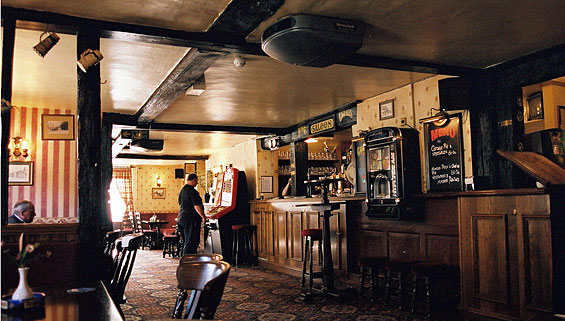


 At lunchtime on Saturday 16 January 2010, workmen boarded-up all the ground floor windows and doors of this grade II building, ending and encapsulating the life and times of Stortford's oldest recorded pub. Between 2001 and the present day (2010), social economics and new laws have helped force the closure of seven pubs throughout the town but none suspected the daddy of them all would also become a victim of the same factors.
At lunchtime on Saturday 16 January 2010, workmen boarded-up all the ground floor windows and doors of this grade II building, ending and encapsulating the life and times of Stortford's oldest recorded pub. Between 2001 and the present day (2010), social economics and new laws have helped force the closure of seven pubs throughout the town but none suspected the daddy of them all would also become a victim of the same factors. Two memorable years in the town’s history were 1629 and 1630, when Charles I ‘dyned at ye George’ and the bells of St Michael’s church rang out to celebrate the fact. That same century, Charles II rejected the royal palaces at Theobalds and Royston in favour of a move to Newmarket, making Bishop’s Stortford, and in particular the George, a convenient mid-way stop for him and his entourage while journeyings to and from London. Coupled with his love of the Newmarket races the King’s visits were frequent, but he disliked travelling through the busy town centre and hated even more the sight of the ‘cage’ that stood in the road outside the George.
Two memorable years in the town’s history were 1629 and 1630, when Charles I ‘dyned at ye George’ and the bells of St Michael’s church rang out to celebrate the fact. That same century, Charles II rejected the royal palaces at Theobalds and Royston in favour of a move to Newmarket, making Bishop’s Stortford, and in particular the George, a convenient mid-way stop for him and his entourage while journeyings to and from London. Coupled with his love of the Newmarket races the King’s visits were frequent, but he disliked travelling through the busy town centre and hated even more the sight of the ‘cage’ that stood in the road outside the George. From the late 18th century to the early 19th century the inn served as Bishop’s Stortford’s Excise Office and, later, as a terminus for stagecoach services journeying to and from London and Saffron Walden. Two Stortford based coaches were owned by Henry Gilbey and William Low (See Guide 4). Gilbey's coach left the George at 5 am on a Monday morning and arrived in London at the Bull Inn, Aldgate, around 9 am. The return journey departed around 4 pm. On other days of the week the coach left for London at 8 am, running daily during the summer months and on alternate days in winter.
From the late 18th century to the early 19th century the inn served as Bishop’s Stortford’s Excise Office and, later, as a terminus for stagecoach services journeying to and from London and Saffron Walden. Two Stortford based coaches were owned by Henry Gilbey and William Low (See Guide 4). Gilbey's coach left the George at 5 am on a Monday morning and arrived in London at the Bull Inn, Aldgate, around 9 am. The return journey departed around 4 pm. On other days of the week the coach left for London at 8 am, running daily during the summer months and on alternate days in winter.